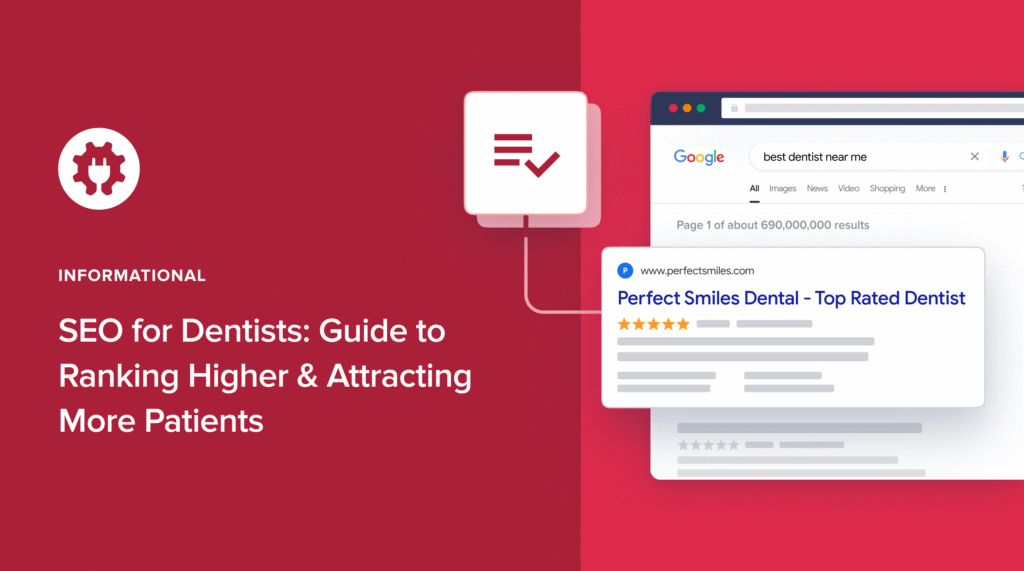Running a dental practice today means more than just offering great service. It also means being found online. Whether you’re a solo practitioner or part of a growing dental group, search engine optimization (SEO) can help you attract more local patients, build trust, and grow your practice.
I once worked with a local dentist who had amazing reviews and happy patients, but their website barely showed up in search results. After implementing just a few basic SEO strategies, their appointment bookings nearly doubled within 6 months. That’s the power of being visible when people are searching for dental care.
In this guide, I’ll walk you through how to do SEO for dentists and the tools that can help you get results.
In This Article
SEO for Dentists: Why It Matters
When someone has a toothache, needs a cleaning, or is looking for a cosmetic procedure, they’re going to Google. Studies show that 68% of online experiences start with a search engine. Which means you need to optimize your website and content for better search visibility.
In short, if your dental website doesn’t show up near the top of the results, you’re missing out on patients. Besides that, here’s why SEO is essential:
Local Visibility
Most dental patients are looking for services nearby. When someone searches for “dentist near me” or “emergency dental care [city],” you want your practice to show up at the top. Local SEO helps your clinic appear in Google’s Map Pack and local search results so nearby patients can find and contact you quickly.
Trust and Credibility
Higher rankings create a sense of professionalism. When your website appears on the first page of search results, potential patients are more likely to see you as a trusted provider. For example, a clean, fast-loading site with positive Google reviews can give the impression that you run a modern, reputable practice.
Better ROI
SEO is more cost-effective than paid ads over time. While pay-per-click (PPC) ads stop working when you stop paying, a well-optimized blog post or service page can bring in organic traffic for months or even years. Investing in SEO builds a long-term asset for your practice.
Check out our article on SEO vs. PPC for more details on this.
Before You Get Started, Invest in the Right SEO Tools
One of the first steps to mastering SEO for dentists is to use the right SEO tool. For WordPress users, there’s no better plugin than All In One SEO (AIOSEO).
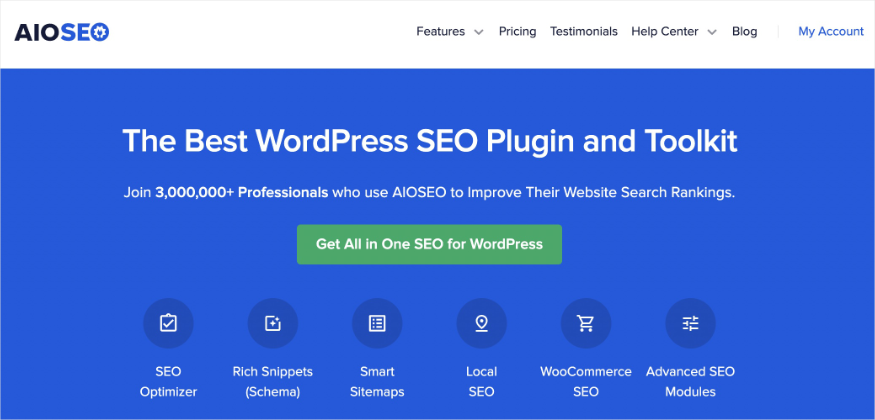
AIOSEO is a powerful, easy-to-use SEO plugin with over 3 million active users. Because it’s regularly updated, you can rest assured that the plugin stays up to date on changes in SEO best practices and WordPress versions. It also has features that can help you rank your dental practice’s website higher on Google and other search engines. Examples of said features include:
- AI Writing Assistant: Use the power of artificial intelligence (AI) to optimize your content for better search rankings.
- Author SEO: Boost your Google E-E-A-T signals right in WordPress, giving you an edge over competitors.
- AI Content Generator: Automatically repurpose blog posts into FAQs, email copy, key points, social media posts, and more from your blog posts.
- Advanced Robots.txt Generator: Easily generate and customize your robots.txt file for better crawling and indexing.
- TruSEO Score Analysis: Makes it easy to spot on-page SEO issues and gives recommendations for fixing them.
- Next-gen Schema Generator: This no-code schema generator enables you to generate and output any schema markup on your site.
- Link Assistant: Powerful internal linking tool that automates building links between pages on your site. It also gives you an audit of outbound links.
- And more
Furthermore, AIOSEO is packed with features to help you improve your local SEO, on-page SEO, and technical SEO. We’ll look at features that specifically help with SEO for dentists in the sections below.
For step-by-step instructions on how to install AIOSEO, check our detailed installation guide.
How to Do SEO for Dentists: 10 Proven Best Practices
Improving your dental website’s visibility isn’t just about ranking higher. It’s about helping the right patients find you at the right time. These proven best practices will guide you in building a stronger online presence that brings more people through your doors.
1. Optimize for Local SEO
One of the first steps to bolstering your dental SEO is to nail your local SEO. This is the practice of optimizing your content so that it ranks well in related local searches.
Local SEO ensures that people in your area can find your dental practice when they need it most. As a dentist, your potential patients are often just a few blocks away, and they’re searching for help on Google.
Here’s how to get started:
- Claim and optimize your Google Business Profile: This helps you show up in local Map Packs and searches. Add photos, hours, services, and a compelling business description.
- Use consistent NAP (Name, Address, Phone Number): Make sure your contact info is the same across all directories, like Yelp, Healthgrades, and Facebook.
- Encourage reviews: Ask satisfied patients to leave Google reviews. These improve visibility and trust. One glowing review can convince someone to choose your clinic over a competitor.
- Add local keywords: Include phrases like “dentist in [city]” or “emergency dental care [neighborhood]” on your website, especially on service pages and blog posts.
Check out our guide to creating impactful local SEO strategies for more information.
One of the best tools to help you nail your local SEO is AIOSEO. One reason for this is the Google Maps integration, which can help you rank higher on Google Maps.
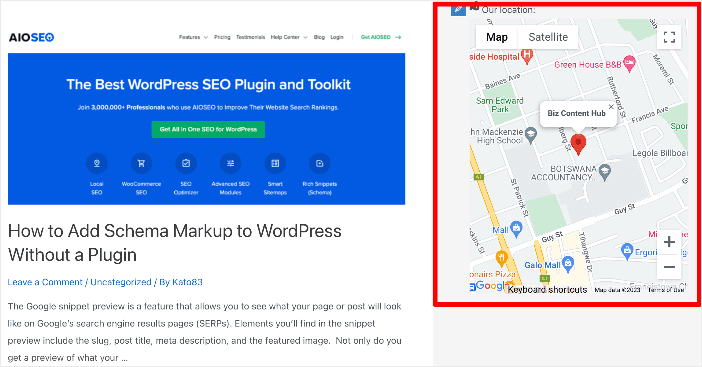
This feature gives search engines the necessary data to help your target audience find you. Plus, it also supports multiple locations.
2. Build a Mobile-Friendly Website
Think about your own browsing habits. How often do you use your phone to look up a business? Most of your potential patients do the same. If your website is hard to use on mobile, you’re likely losing out on appointments.
This is why you must invest in mobile SEO.
To boost your dental site’s mobile SEO, ensure it’s:
- Responsive on all devices: It should look and function well on phones, tablets, and desktops.
- Fast-loading: Patients won’t wait more than a few seconds. Use site speed tools like Google PageSpeed Insights to check your load time.
- Easy to navigate: Keep the menu simple and make key info like contact details and appointment booking easy to find.
- Secure (HTTPS): A secure site builds trust and is favored by search engines.
Google also uses mobile-first indexing, meaning your mobile site, not the desktop version, determines your ranking. If your site isn't mobile-friendly, you're already behind.
3. Use Relevant Keywords
Keywords are the bridge between your website and your next patient. This is why keyword research is a crucial step to winning at SEO. By targeting what people are actually searching for, you increase your chances of showing up at the top of search engine results pages (SERPs).
To get started with keyword research, you need the right keyword research tools. Personally, I’ve found LowFruits to be the best for niche sites like dentists’ websites.

LowFruits is a keyword research tool designed to uncover low-competition keywords—perfect for quick SEO wins. It identifies Weak Spots in the search results, allowing you to target keywords with a higher chance of ranking. Plus, it provides valuable data on search volume, keyword difficulty, and related keywords to help shape your SEO strategy.
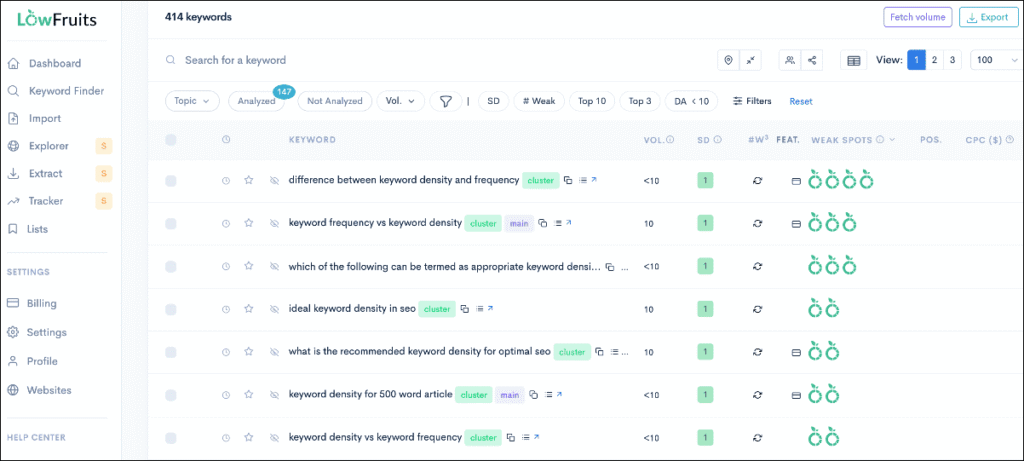
Focusing on keywords with lower competition increases your chances of ranking higher in search results more quickly.
To get keywords that are impactful, think about the services you want to promote and the words patients might use. For instance, if you’re targeting nervous patients, a phrase like “pain-free dental care in [city]” could work well.
The goal is to rank for terms that lead to bookings, not just website traffic.
4. Create Helpful, Optimized Content
A blog isn’t just nice to have. It’s an SEO non-negotiable. When patients have questions about dental procedures or oral health, they turn to Google first. By answering those questions through well-written, optimized blog content, you're helping people and improving your online visibility.
Content quality has always been an essential part of SEO. However, with Google’s Helpful Content update, it can’t be overstated. This is especially true for sites in the Your Money, Your Life (YMYL) category, like dental practices. Since your content impacts people’s health, Google expects it to be accurate, helpful, and trustworthy.
For example, I once worked with a clinic that wrote a detailed post titled “What to Expect During Your First Root Canal.” That single post ranked on the first page and brought in dozens of new visitors every month.
So, what does optimized content look like for dental SEO?
Make sure your content has:
- A clear headline (H1)
- Keyword-rich subheadings (H2, H3, H4)
- Internal links to services
- Local mentions
In short, helpful content builds trust with both search engines and patients. The more useful and locally relevant your content is, the more likely it is to bring in steady traffic—and real appointments—for years to come.
5. Demonstrate Google E-E-A-T
Google’s E-E-A-T guidelines—Experience, Expertise, Authoritativeness, and Trustworthiness—are used to assess the quality and credibility of your website’s content. By showcasing strong E-E-A-T signals, you not only boost your chances of ranking higher in search results but also build trust with your audience.
To demonstrate E-E-A-T, you can take several steps:
- Showcase your dental expertise: Highlight your qualifications, experience, and knowledge in your field. This can be done through your “About” page, author bios, or by featuring relevant credentials and awards.
- Establish authoritativeness: Demonstrate your authority by creating high-quality, well-researched content that provides value to your audience. Regularly publish new content and update existing posts to maintain relevance.
- Build trustworthiness: Earn the trust of your audience by providing accurate, reliable information and being transparent about your practice. Display customer testimonials, case studies, and social proof to build credibility.
To demonstrate E-E-A-T, you could include your dental credentials (like your DDS or DMD degree) in your bio. You can also include years of experience and any professional associations you belong to. This helps build trust with both patients and search engines. You can easily do this using AIOSEO’s Author SEO module.

This tool makes it easy to create SEO-friendly author bios that align with E-E-A-T. With built-in author schema markup, search engines can quickly recognize your expertise and authority. It also helps highlight your experience, thereby building trust.
For detailed information, check out our author SEO guide.
6. Build Topical Authority
If you want to show up consistently in search results, it’s not enough to write a single blog post about teeth whitening or root canals. You need to demonstrate that your practice is an expert in dental care overall. If you’re a specialist, your content should reflect that.
That’s where topical authority comes in.
What Is Topical Authority?
Topical authority means building deep expertise around specific dental subjects by creating clusters of related content. Instead of writing one article about dental implants, you write multiple posts that cover related topics like implant recovery, cost, aftercare, and comparisons with other procedures.
How to build topical authority as a dentist:
- Create topic clusters: Choose a core topic like “cosmetic dentistry” and create supporting articles like “What is teeth whitening?”, “Veneers vs. bonding,” or “How long does teeth whitening last?”
- Write cornerstone content: This is your main, in-depth guide that links to all the cluster articles. Think of it as the hub.
- Interlink everything: Use internal links to connect the content and help Google understand how it's all related.
This not only improves rankings across multiple keywords but also builds trust with patients who see your website as a complete resource. Building topical authority this way is easy with an SEO tool like AIOSEO. For one, it has a Cornerstone Content feature that makes it easy to mark your important pages as cornerstone.
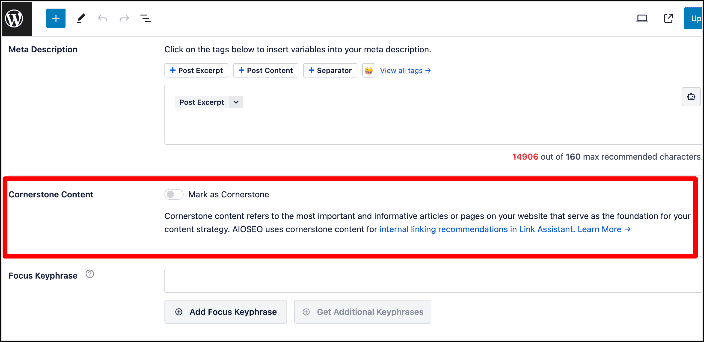
AIOSEO’s Link Assistant makes it easy to create the links to and from these pillar pages. It automatically suggests relevant internal links and helps you add them with just a few clicks—no manual searching required.
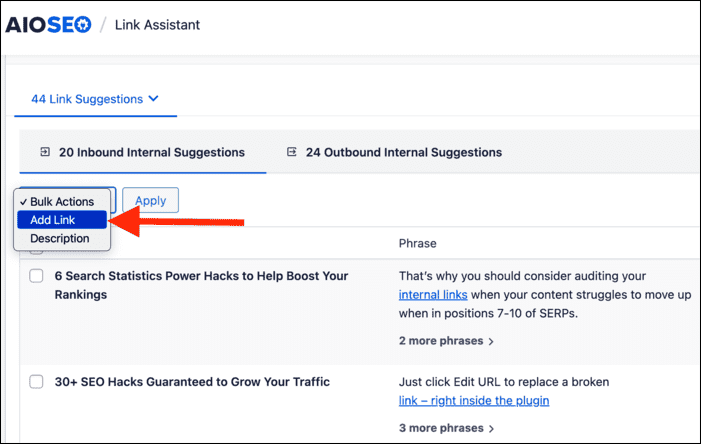
This strategy shows Google that your practice is a trustworthy authority in your field. This leads to better rankings, more traffic, and more booked appointments.
7. Optimize Service Pages
Another best practice when doing SEO for dentists is to optimize your service pages.
Each dental service you offer should have its own dedicated page. This helps both SEO and patient experience. When someone searches for a specific service, like “emergency tooth extraction,” they want to land on a page that speaks directly to their needs.
I’ve seen dental websites with just one generic service page miss out on valuable traffic. But when they broke it into individual service pages, each optimized for specific keywords, they quickly saw a boost in rankings and calls.
Example service pages you can add and optimize include:
- Teeth Cleaning & Exams
- Emergency Dentistry
- Cosmetic Dentistry
- Dental Implants
- Pediatric Dentistry
For each service page, provide clear explanations of what that service entails. Don’t expect your prospects to have full knowledge of it.
Another way to optimize your service pages is to include FAQs. This is one of the strategies I use to rank in AI Overviews.
Again, doing this is easy with AIOSEO. It has a feature called AI Content that can automatically repurpose your content into FAQs.
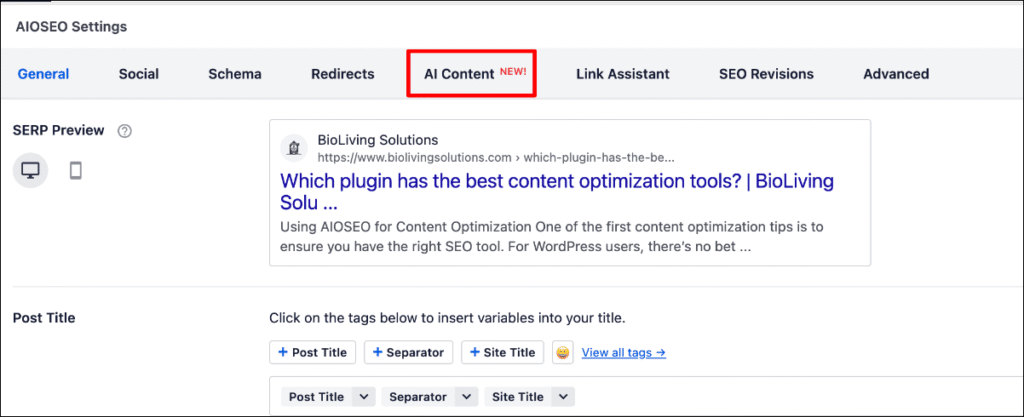
One thing I love about this feature is that you can use it to add your FAQs right into your page, complete with FAQ schema. All with just a few clicks.
For more tips on optimizing your service pages, check out our homepage SEO guide. The principles are transferable.
8. Add Schema Markup
Structured data is a type of code you add to your website to help search engines better understand your content. It uses a standardized format called schema markup to define key details about your pages, like whether a page is about a recipe, a product, or a local business.
While this code isn’t visible to visitors, it helps search engines display your content more effectively in search results. This is often through enhanced features like rich snippets.
Schema markup might sound technical, but it’s one of the simplest ways to improve your site’s SEO. And with AIOSEO, you don’t need to write code to do it, thanks to the next-gen Schema Generator.
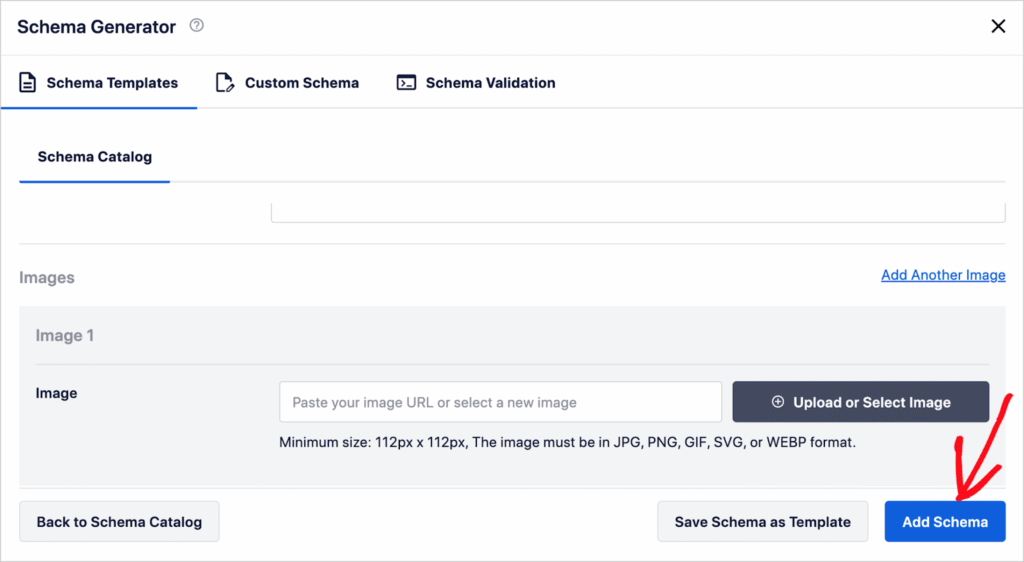
Schema gives search engines extra context, which can lead to rich results like star ratings, FAQs, or business hours showing up directly in search results.
For example, if you use review schema, Google can show your 5-star ratings under your listing, making your practice stand out from the competition. Types of schema markup you can add to your dental site include:
For detailed instructions, check out our tutorial on adding schema markup in WordPress.
9. Get Local Backlinks and Citations
A backlink is a hyperlink from one website to another. Backlinks from other reputable websites help boost your domain authority and signal to search engines that your site is trustworthy. But for dental practices, local backlinks are even more valuable.
Here are some great ways to build local backlinks:
- Sponsor community events or charities: These often result in a mention and a link from the event’s website.
- Join the local Chamber of Commerce: Listings on trusted local directories add credibility and backlinks.
- Get listed in dental and health directories: Sites like Healthgrades, Zocdoc, and the ADA directory not only offer exposure but also valuable backlinks.
- Collaborate with local influencers or bloggers: Reach out to local parenting bloggers, lifestyle influencers, or healthcare writers and offer to provide dental tips or guest content.
A clinic I worked with partnered with a local wellness blogger, and that one backlink led to a noticeable bump in local rankings and first-time visitors to the practice.
For tips on building backlinks, check out our ultimate link building guide.
10. Build Consistent Citations
Citations are a foundational part of local SEO, and are especially important for dental practices that rely on local foot traffic. A citation is any online mention of your business’s Name, Address, and Phone Number (NAP)—with or without a backlink.
Think of citations as digital trust signals. The more consistent and widespread your NAP info is across the web, the more confident Google feels about showing your practice in local results.
Why do citations matter for dentists?
Citations help:
- Boost your visibility in Google Maps and the Local Pack.
- Reinforce your practice’s legitimacy and authority.
- Drive traffic from high-visibility directories.
- Strengthen your overall local SEO strategy.
And here’s the key: Citations don’t need a link to help your SEO. What matters most is consistency.
For detailed instructions on this strategy, check out our tutorial on building local SEO citations.
Final Thoughts: Be Consistent and Patient
SEO takes time, but it’s worth the effort. By optimizing your website, creating useful content, and staying active in your local community, you’ll steadily climb search rankings and attract more patients.
The key is consistency.
Start with a website audit, then focus on one improvement at a time. Small, consistent actions lead to long-term success.
If you’re ready to boost your dental practice online, use the best SEO practices and tools we covered here to take your first step.
Need help? Our team of SEO experts is available to help you with on-page SEO and technical SEO implementation.
I hope this post has helped you know how to master SEO for dentists so you can boost your rankings, traffic, and bookings. You may also want to check out other articles on our blog, like our beginners’ guide to SEO or our ultimate WordPress SEO checklist.
If you found this article helpful, then subscribe to our YouTube Channel. You’ll find many more helpful tutorials there. You can also follow us on X (Twitter), LinkedIn, or Facebook to stay in the loop.
SEO for Dentists: Your FAQs Answered
Why is SEO important for dental practices?
SEO helps your dental website show up in local search results when potential patients look for services like “dentist near me” or “teeth cleaning in [your city].”
How can I improve my dental website’s SEO?
Start by optimizing your content and site using an SEO plugin like All In One SEO (AIOSEO). AIOSEO makes it easy to perform SEO tasks that can help you rank high on search engines and outperform your competitors. The best part: you don’t need any technical knowledge to use it.
What kind of blog content should a dentist publish?
Focus on answering common patient questions, such as “What to expect during a root canal?” or “How to choose between Invisalign and braces.” This builds topical authority and helps your site rank for relevant keywords.
Disclosure: Our content is reader-supported. This means if you click on some of our links, then we may earn a commission. We only recommend products that we believe will add value to our readers.
